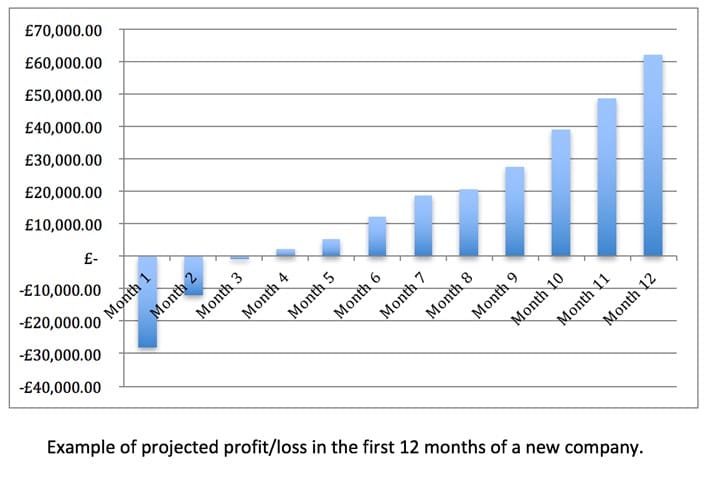In this post
Business plans are used to outline the industry in which a business is working in as well as the economic structure of a company to give an idea of the financial prospects of a business. They are used primarily to organise the routes to market that a company will take and give projections on earnings and target dates for when the company expects to have a certain income.
Writing a strong business plan is important for any business, whether large or small, and is the perfect way to map out your route to success. Not only will the plan contain your aims and plans to attract new customers but it can also act as a strong tool for financial projections and help you to set out goals for your company. Throughout the units that we have already covered on this course we have seen a lot of aspects that could be included in a business plan, and including as much information as possible is key.
A lot of entrepreneurs fail to produce a clear business plan when they set up a new company and this can be a big issue further down the line. By not outlining your company and its operations you may affect the business in a negative way and be unable to keep track on the progress and route the business is taking. If you are seeking finance to launch your company it is more than likely that you will need to create a business plan to secure a loan, but this should not be thrown away once you have started the business. Your plan can be updated and adapted at any time and you must try to keep things relevant and up to date so you know the long-term aims of your company.
Why create a business plan?
Some entrepreneurs fail to create a business plan before starting a company because they feel it is a waste of time. They know what they want to do, how they want to do it and everything that is needed has been formulated in their heads. This is a very good skill to have, but without your thoughts and projections down on paper it can be very easy for them to become misinterpreted, forgotten or skewed. Simply having things thought out in your mind is not enough to convince others or explain your strategies to those you are working with. Business plans are used to organise your approach and produce a strategy that allows you the best possible chance of success. They should include:
- Information about your company so that you can plan the structure and objectives which you have
- Your relationships with others and how these can be used (e.g. banks, lenders and accountants)
- To find weaknesses in your plans and areas where you must improve
- Areas for discussion so that you can find out other people’s opinions and include them in the planning process
Some people start a business and want everything to be done immediately. With great confidence that they can do it all alone and have no input from experts, they may not stop and think about forming a clear plan that includes facts and figures to help them along the way. Doing this can be of massive detriment to any business and you need to gather as many opinions, facts and ideas as possible from those around you.
What to avoid
A business plan should include lots of information but there are a few things that should be avoided. You should put some restrictions on the long-term (over 1 year) predictions of your finances. A long-range prediction on the amount of money you will have coming into the business can be completely meaningless because it is very hard to predict how a business will perform far into the future.
Very few business plans get the figures projected spot on, so remember to give a good indication of what you expect to earn but try to be conservative with this. By exaggerating the earning potential of the company you will not be impressing anyone and this will make it difficult for you to plan your spending. Outline clear time frames and indicate your aims during these periods. Try to show what you will be working on at any time, for example if your business will take quite a lot of setting up then the first 6 months may be devoted solely to this and you should outline this in your plans and projections. Try to correctly anticipate the money and time that will be required for processes to be completed and always factor in a margin of error. By slightly exaggerating the money that will be required when completing a stage of expansion or setting more time than is needed, you will be well prepared if some unforeseen issue crops up.
Don’t just use the business plan to explain how great your product or service is. This alone will not turn your business into a big success (although it is very important). Identifying areas to improve and how you will market your company is much more important than simply relying on the uniqueness of your product.

The purpose of a business plan
Business plans are used for a variety of different reasons and the importance of these should not be underestimated. Creating a plan that is precise and includes information that is relevant to the new or existing business will ensure that ideas are implemented quickly. Without a solid business plan it will be much more difficult to judge the success of the new venture and the direction of the company will be hard for everyone to see.
Minimising risk
The risks when starting a new business can be huge. Money is invested into new businesses and time will also be spent on getting a company off the ground. Without a business plan in place, owners and employees could end up wasting their time in certain areas. Using resources inefficiently and having no clear direction for a business can lead to disaster very quickly. The best way to avoid this is with a clear outline of what the business needs to work on and what resources will be needed in order to make the venture work. A business plan will be used to set goals and objectives while losing no time in areas that do not see a large enough return on the investment.
Securing finance
Many people use business plans to secure finance for a new venture. This finance can come from several different sources such as banks, investors and start-up funds. Having a business plan that shows exactly how the business will operate and where money will be made will act as a way to convince potential investors to finance the company. With clear profits to be made and a route to market mapped clearly, investing in a business will be a much more desirable prospect for a potential investor.
Formats of business plans
There are many different formats which a business plan can be created in but the main areas to cover are:
- Executive summary
- Company summary
- Products and services
- Market analysis
- Strategy and implementation
- Management and personnel
- Financial plan
Executive summary
Any business plan should include an executive summary which gives an outline of the business and the vision of the owners. Here you should briefly explain the business and its activities as well as the key areas that will help the company to succeed. A mission statement can be included to explain why your company will be unique in the market and what will give you the edge over your competitors.
You should also include some information about the financial aspirations of the company here to show the economic aims over the first few years in operation. Remember, these do not need to be hugely accurate and taking a realistic look at what can be earned is essential. It is usually best to complete the executive summary of the company last as you can include information from other sections in this part of the plan to give a good overview and concise insight into the business and your plans.
Company summary
The company summary will explain key aspects of the operation of the company. This includes the owners of the business as well as where the business is located. Information about all directors must be included in this area of the plan and you should summarise their roles within the organisation. If you have any other personnel that will be involved at a senior level then they should be included also. In this part of the business plan you need to outline the funds required to set up and maintain the business also. By including information about the company’s location and operations you will be able to forecast the money required to get the company started and any investment that will be needed. Try to include a spreadsheet showing where the initial funding will come from and how much is being put into the business to start with. Remember, most new businesses make a loss in their first year due to the expenses involved in starting a new company, so be realistic. Plan the initial outlays and costs carefully and make sure you know the limits to how much you can put into the company to get started.
The location of the business can also be included here and any rent that you will be required to pay can be outlined and the costs per square foot for the company premises. Then you can go on to make projections about the sales required to cover all of your fixed costs such as office and equipment rentals.
Products and services
Next we move on to explaining the things which will earn your business money – the goods and services that you have to offer. In this section you must include descriptions of what you can offer your customers and the prices you will be charging. Outline what makes your goods and services special and the key aspects that will influence potential clients and convert them into paying customers.
It is also a good idea to compare your pricing structure to your competitors. It may be that you offer the same products but cheaper, or with any additional features to make your products more appealing. You should explore the need for your products and services to be better than any of the competition. As a new business you may struggle to compete unless you have something that nobody else has. By bringing to the market something which is already selling well with another company that has established its brand in the marketplace, you might struggle to take a large enough section of the market to warrant starting a whole new company. If this is the case then you must compare your pricing to your biggest competitors and ensure that you are competitive.
In this section you can also include any products and services that you may offer in the future. Explain your product development processes and how you will be able to innovate and bring new products or services to the marketplace.
Market analysis
Next you need to carry out some market analysis to identify your potential customers. In this section of the business plan you need to include information about your ideal customers and what sort of people they will be. Think about the earnings of your potential clients, the type of lifestyles they will live and the products and services they expect from a business. This part of your plan is great for you to use figures about your market and show any growth projections for the sector in the future.
Explain market trends and analyse the need for your goods/services in this sector. Attempt to find some facts about the disposable income of your potential customers and target certain people who will be interested in what your company offers. Think about how you will be attracting your customers and the potential for growth over the first 3 years in operation. Make estimations about the number of people in the area where you will be offering your products and services to get a good idea of how many different potential clients you can attract. Having a good understanding of your target market will give you the tools to design marketing strategies and techniques to attract the maximum number of customers to your business.
Strategy and implementation
Having outlined your market and explained who your products/services will attract, it is time to explain your techniques when doing this and show how you are going to market your company. Explain the key aspects of what you offer and the main selling points that should be tailored to suit the target clients that you have in mind. Products designed for the more affluent will need to be luxurious and have an exclusivity about them, whereas items that are for people with limited incomes will need to offer greater value for money. Try to understand a clear link between the market in which you will be operating, your potential clients and the main aspects of your business which you should focus on.
Ensuring that your business suits the needs of customers is essential to getting the most customers. For example, opening up a luxury spa in an area where there is high unemployment and typically lower incomes will encounter lots of issues as the potential customers (those within a 15-mile radius) will have no need for this service and may not be able to afford what you have to offer. You will need to come up with at least five ways of promoting your business that will appeal to your target market and attract clients. Remember all of the techniques and skills we discussed on marketing and try to link what you know about your potential clients to the advertising methods you will use.
Here you can also outline the potential sales forecasts and investments which you will make when promoting your goods and services. Come up with some realistic projections about the money to be spent on advertising and increasing awareness of your brand as well as any sales targets you may wish to set. Be conservative with your sales projections as it takes time for any business to get a good level of customers and building brand awareness does not happen overnight. Your sales in year 1 will normally be fairly low and you need to take this into account when projecting your income and the amount it will cost to set up your company.
Management and personnel
The next thing to plan is the personnel involved in your business. This will include the owners and directors as well as any senior managers that are to be involved in the company. Explain the team structure and hierarchy of your new company and the number of employees you will be hiring. Knowing the team behind the company and their individual duties will let you outline the various skills that your team possesses and establish each person’s duties within the organisation.
Outlining the duties of each person and giving a brief job description is a good way for you to understand the team dynamic and responsibilities of each member. Most new companies make the mistake of hiring too soon, but with a clear plan of the business personnel that will be involved in your company you will be able to ensure each person is needed for the business to operate. Establishing a business will require you to be frugal in your approach and employing staff that are not needed can have a terrible impact on your profits and end up costing you tens of thousands of pounds a year.
Outline the wages of your employees and then come up with some totals for staffing costs that can be used when writing your executive summary.
Financial plan
Your financial plan will provide a clear breakdown of all the income and outgoings of the business that you expect. These will only be projected figures so will be likely to change in reality, but you should be able to predict fairly accurately using your knowledge of costs incurred and the pricing and potential customer base for your products/services.
Make projected figures for your fixed and variable costs as well as the profits you expect to earn from sales. This will then help you to create a break-even analysis for your company that will show the amount of money required to cover all of your outgoings. Remember that your first year will have fixed and variable costs as well as additional outgoings which come from setting up your company. You will also have a limited number of sales during the first 12 months as you build up your customer base, so the projected net profit for year 1 will be lower than any other year. Try to think about the most popular goods/services you offer and come up with an average sale price for your customers. This will then help you to identify the number of customers you need in your first year to break even.
Come up with some cash flow and profit and loss charts (look over our work in Unit 1.3 to help) to project how much money you can expect to see in the business each year. This will help you to come up with clear and concise predictions for how much money you will be making in your first three years.


Reformulating a business plan
If you do ever happen to make a slight error in judgement on your initial business plan this can always be altered and the plan changed as required. The chances of figures being completely correct in your first projections are very slim and there will be certain things that you miss or random payments to be made when setting up your business which you did not account for. This is the main reason why being conservative with your income projections and adding in a ‘safety net’ figure to your costings will help you to deal with these circumstances. Business plans should be flexible and are a working document, so chopping and changing them is fine. When doing this try to use what you already have to create a new plan for the next few years rather than just altering figures to make it look like you got the initial plan correct.
Business plans are working documents, so they should be altered and added to as time goes by to determine where your company is heading and how it will get there. Being understanding of the nature of business and the fact that you will not be able to predict certain outcomes will give you an edge and allow you to put in place certain measures to help if you ever do come up against any problems.




